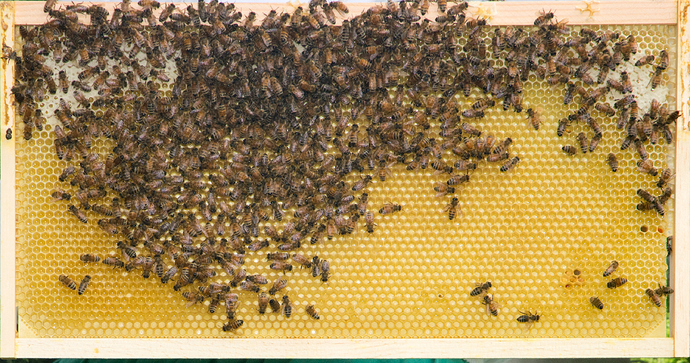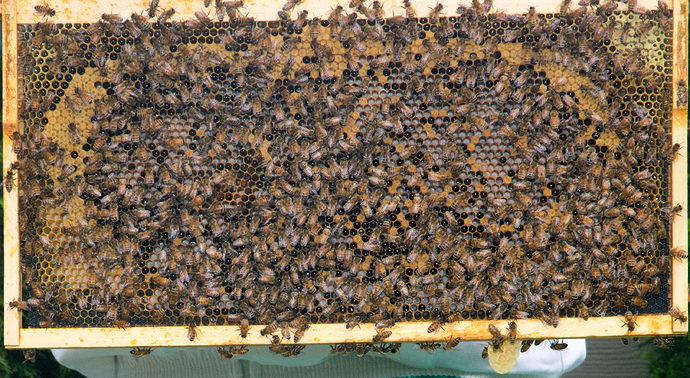Hello,
I would love some feedback on these frames, I installed a 5 frame nuc 12 days ago into a 10 frame box - yellow waxed foundation are the frames I added. I may not have a picture of the first or last frame because there wasn’t much going on, just a bit of new white comb but no visible nectar or eggs. I think these pictures are both sides of the other 8 frames. I’m in Columbus, Ohio, USA. I have been feeding syrup. Any comments or concerns from the more experienced beeks would be greatly appreciated. TIA! Will try to get higher res images next time…
Lovely photos. Looks healthy. Nice brood pattern. Plenty of bee bread. They are beginning to store honey on the outer frames. Queen in photo 5 looks beautiful.
Well done! 
There is plenty of everything you would want to find in a healthy strong hive in that set of pics of brood frames.
Cheers
Thank you Dawn and Peter! I was going to add another box - think it’s ok to do that now? When should I stop feeding?
Local beeks have said that the last major flow is (already) done by mid-June but there are some small ones that end by late-Aug. So, I figured I would need to feed until they have built everything up and capped their honey for winter.
Too early. You need all of the following:
- Every frame has fully drawn comb on most of the frame (you don’t have this), and
- Every frame is 80% full of food or brood (you don’t have this), and
- Every frame is completely covered with bees (don’t have this either)
When all of the above are true, the bees need more space, and they will have the numbers to use, defend and heat the new space. ![]() That will probably take at least another couple of weeks, maybe longer.
That will probably take at least another couple of weeks, maybe longer.
I would continue feeding them until they need another box.
Ok. I thought maybe they just didn’t like the plastic foundation and maybe they would work a foundationless frame better/faster/happier because they are building comb underneath the already drawn frames.
I still have my entrance reduced (the medium size). Also continue? Doesn’t seem that crowded at the entrance except in the late afternoon or if it’s about to rain.
Not sure what medium size means, as all reducers are a little different. I have my entrance reduced to about 6 inches (15cm) wide all year round. I do this because Tom Seeley (famous bee researcher) did a very good study where he let bees decide which entrance size they preferred on their hives. He came up with 15 square centimeters. As the Flow entrance is about 1cm high, I made my entrance 15cm wide. Bees seem to like it. When there is a heavy flow, I sometimes use an upper entrance too, but not when there is any risk of robbing (during a dearth, weak hive, etc).
I have a Mann lake reducer - I guess small is the 1” opening, medium is the 4-6” one and large is fully open. 
I would stick with the medium then. I only use small entrances when wasps/hornets or robbing are a problem. 
I have all my hives with about 4" entrances after a lot of experimenting. Dawn uses 6" and that is ok, but the main thing is to reduce the entrance to make it more defendable against robbing and reduce cold drafts blowing onto the brood area.
Opinions vary a lot about when to stop feeding, or even feeding a hive at all. I feed my new splits as a booster for them in making new comb. I only add new frames or wired frames and add a full sheet of foundation to them. That gives the bees a frame that will produce less drone comb and the bees will make the frame usable faster for the queen to lay in. I have tried plastic foundation and have had issues with them. Some concerns on the forum about bees wax foundation in the US with chemical contamination as an argument against it.
Cheers
(I’m embarrassed to say) I didn’t follow your advice last week, Dawn…
I put foundationless frames with paint stirrer starter strips (all smeared with softened burr comb from my hive) in positions 2 and 9 in the bottom box and put those (partially drawn) frames with foundation in position 2 and 9 of the upper box, with wax-smeared foundationless frames with paint stirrer sticks for the other 8 frames.
I realized after the fact, as I was second guessing my decision not to take your advice, that the general consensus seems to be that glue alone is insufficient for holding the starter strips on a honey-filled deep foundationless comb and I was reading the comb collapse thread -
https://forum.honeyflow.com/t/foundationless-frames-wax-collapse-yikes-should-i/26535
with horror…
So, I decided I should go back in early and follow your advice and just take off the second box and the new frames.
But when I had a chance to get back in there (3 days later) I found that the two new foundationless frames from the lower box were almost completely drawn and they had started on 6 of 8 the new upper frames and had finished drawing out the frames I moved up. All the new comb looked nice and straight, right off the edge of the starter strip. I had a dilemma…
The bees were very calm and I didn’t want to disturb their new soft comb by manipulating the frame too much… I ran inside and I got a narrow crown pneumatic stapler and managed to pop four 5/8”staples across the top bars to secure the paint stirrers with bees still all over the frame I was afraid to shake the or brush them off the new comb. I figure 5/8” was long enough to cross the groove… Mostly the bees didn’t even look up - a couple flew off when the exhaust from the stapler blew them off the edge of the frame… Too busy building comb, I guess!
Hopefully, all’s well that ends well. I didn’t have time to set up a camera nor did I have an assistant to take pictures - I’ll take some next time I look in a couple weeks to decide if I need to continue feeding.
I’m planning to feed until all 20 frames are fully drawn, hopefully also with a significant amount of capped honey since I believe that a dearth is upon us and the late summer flow here isn’t very significant.
Since last winter was extremely mild, I’m sure we’re going to get walloped this winter and I want them to be set up for a long cold stretch.
Don’t be embarrassed. Just record what you did and learn from it. If you have a really great nectar flow at the moment, everything will be fine. If they don’t use the new space, you can reduce them down in the Fall and save the extra box for next year. Thank you for sharing with us! ![]()
@Dawn_SD - What’s you opinion on when to discontinue feeding? I know that some members have said that they never feed a nuc but I don’t really see the downside.
Happy birthday!
Discontinue feeding when all comb is fully drawn, or you are going to put a super on top of the hive for honey collection. Sugar syrup feed doesn’t taste anywhere near as good as nectar-based honey! Once the comb is fully drawn, they shouldn’t need the extra feed until Fall, when you might want to top them up for winter if they have empty frames.
![]()
Sorry missed that bit. I think I am in denial. My birthday was last year, not this year! ![]()
Thank you very much, though.
I am not sure I follow what you wrote… I wasn’t planning on supering this season. I will stop feeding when the frames are all drawn. The nectar flow is over in mid-september I was thinking I would wait until a warm day in Jan and put on some fondant if the hive seems light, although I doubt that I would be very good at estimating the weight…
You would be surprised perhaps at how many people Super a hive and continue to feed. If you are feeding, the super will have syrup in it, probably more than foraged nectar. If you are not planning to super, then this doesn’t apply to you. As this is an open forum, I wanted to make sure that my answer applied to others who had different plans… ![]()
The rest of your planning sounds excellent. Well done!
If anyone has a spare moment and would mind lending me their eyes and judgements, here are 41 pictures from my last inspection (one of each side of each frame with an extra one of the queen). The bees are really reluctant to fill the end frames on plastic foundation. I suppose next spring I will rotate those into the middle by the brood to see if they draw them out more. The naturally drawn frame that is only 2/3 full is next to two really drawn out honey frames and I don’t think there’s a lot of space to draw more comb. Again, maybe next spring I’ll rotate around to get it fully drawn or just drop down to 9 frames in my upper box.
Comments greatly appreciated! Thanks in advance.
My summary is, looks very healthy. I don’t see any chalkbrood. You still have some drones in the hive, but I don’t see any drone brood. That is normal for this time of year. Your queen has a beautiful brood pattern, except in areas where the foragers have put pollen in the brood nest - silly billies! Nice looking queen. 
Here is what I see frame by frame, in the order that they appear in your album:
- Capped honey
- Uncapped honey
- Capped and uncapped honey
- Brood and pollen
- Honey and bee bread
- Honey
- Undrawn and some pollen
- brood and pollen
- Undrawn plus pollen and honey
- Honey
- Brood and pollen
- Brood and pollen
- Brood
- Honey
- Honey
- Brood, pollen, Queen!
- Honey and pollen
- Honey
- Brood and pollen
- Part drawn comb and honey
- Honey
- Some brood and pollen
- Some Brood and pollen
- Honey
- Part drawn comb and honey
- Honey
- Pollen and honey
- Honey
- Honey
- Honey
- Capped brood and pollen
- Honey
- Brood
- Brood
- Brood
- Honey
- Honey
- Some capped honey
- Brood, pollen, Queen
- Honey
- Honey
Phew, my hands ache now from all that typing!
















